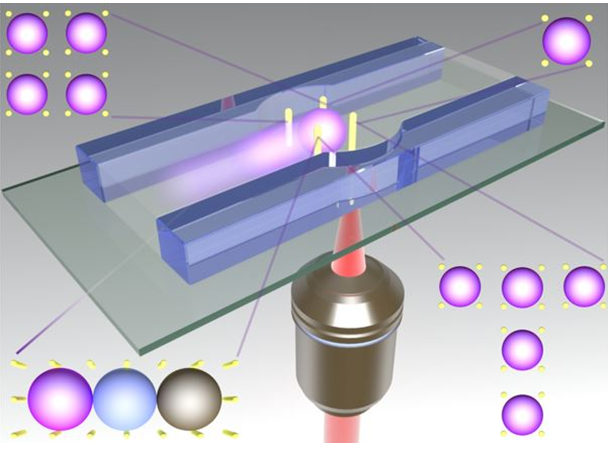If you happen to have the latest Lab on a Chip[Lab on a Chip 18, 442-450(2018)] at hand, just open it and you’ll find University of Science and Technology of China made himself guest here with his great sincerity - entitled “Real-time two-photo lithography in controlled flow to create a single-microparticle array and particle-cluster array for optofluidic imaging”, the paper from Lab of Micro-Nano Engineering in School of Engineering Science, USTC, exhibits a leading footprint in the field of microfluidics. With this progress scientists have made the capture of single micorparticle or cell possible, even with multi particles or cells.In the single cell research, to capture a single cell is the groundwork for further bold attempts. Acknowledged as extremely low-reagent-consuming, high-integrated, portable, environmentally-friendly, highly miniaturized, highly automated, inexpensive and operable, microfluidic chip is way better than conventional experiment approaches, especially in dealing with microfluidic, which makes it broadly applied in capturing a single cell.
Among the approaches, the method to acquire single-microparticle arrays based on microfluidics is the simplest and most universal way to capture and separate cells or microparticles. Nevertheless, scientists are still confronted with some problems: 1. Most cells or microparticles will bypass the micro structure due to its enhanced resistance of a capture unit, resulting in extremely low efficiency of capture(lower than 10%); 2. Real- time control of the size and geometry of the objects is hard to achieve, in that traditional capturing structures are usually produced in the microfluidic chip in advance; 3. Capturing clusters simultaneously in a controlled way is also a tricky problem.

(Real-time two-photo lithography to capture 100% single particles or cells)
Astoundingly, the work from USTC has ever declared that combined with real-time two-photo lithography in controlled flow and through rapid processing technique of microcolumn structures, scientists have made perfectly 100% capture of cells or microparticles. The group firstly designed and manufactured microfluidic chips of some height, and inlet optical resist or hydrogel including object particles or cells to the chips; filtrate the object particles in real time by means of photography and rapidly control the stop flow of liquids; then use the femtosecond laser to process the microcolumn structure around the object particles or cells and wash off the optical resist or hydrogel in the end. After all these being done, the object structures can continue their trip in following research. Also, it is gratifying that all the obstacles described above have been conquered.
Peers think highly of this work as well. As Noriak Horiuchi, vice editor-in-chief of Nature Photonics comments in news&view, the group has put forward a new strategy-Real-time two-photo lithography in controlled flow to create a single-microparticle array and particle-cluster array for optofluidic imaging, to capture object particles around. It is more advanced than traditional methods like improving capturing efficiency to nearly 100% with only 400ms, promoting the accuracy of capturing the object particles or cells among multi particles due to its real-time capturing structure adjustment based on the targets’ sizes and geometry, and, mighty application to almost any pattern of single cells or controlled clusters. Such technique can be adopted in the analysis of single cells, optofluidic, cells counting and etc..
XU Bing, a doctoral student at School of Engineering Science, USTC, is the first author of this paper, with Prof. WU Dong, Associate Prof. HU Yanlei as correspondents. The Lab of Micro-Nano Engineering has been dedicated in this work for a long time and accumulated loads of foundations and experience in processing micro structures and capturing micro objects. Listed below are some of their previous work contributing to the paper.
(written by WEI Lianyi, edited by HUANG Danning )
Contact:
FAN Qiong
Tel: +86-63607280
E-mail:englishnews@ustc.tsg211.com